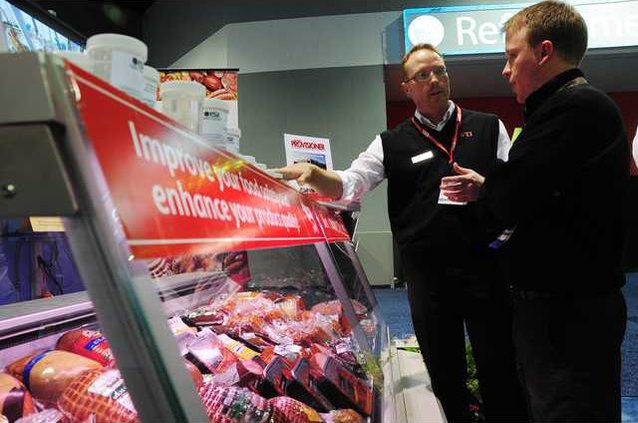ATLANTA — Shiny machines, colored plastic egg crates and even some transport vehicles filled the Georgia World Congress Center on Tuesday as the poultry industry kicked off its annual trade show.
As visitors wove through the booths at the 2012 International Poultry Expo, learning about new products and trying their hands at operating machinery, marketing directors scanned visitors' name badges and handed out promotional materials.
Aviagen, a poultry breeding company based in Huntsville, Ala., was one such company. Businesses could purchase the QR-code scanning service through the trade show, said Beth Cook Bradford, Aviagen marketing communications director.
"We use it to count numbers and see what kind of booth traffic we have. We don't do a mass send-out for ‘thanks for stopping by our booth,' although some people do get that information for that purpose," she said. "We started it to quantify the amount of traffic we got and see if it was worth it to spend money on this booth. So far, it has been."
Like Aviagen, Gillsville-based Morris Hatchery's booth was a place to meet with existing customers.
Morris Hatchery exports broiler hatching eggs all over the world, with markets in Canada, Russia, Ukraine and Dubai, among others, said Rickey Smith, vice president.
"This is normally a really good show for us because of the international travel," Smith said. "We have new clients and also we see a lot of our international customers."
And international it was. The trade show provided translators for visitors from countries including Turkey, Mexico and China.
Mike Atherton, managing director of Technical Services and Supplies, came all the way from England.
His family business manufactures egg quality testing devices used by governments, universities and poultry companies.
The equipment checks for cracks in eggs and tests egg freshness and yolk color.
"When you break an egg and it covers the bottom of a pan, that's a stale egg. When the egg sits very small, very proud and very high (once cracked), that's a fresh egg," Atherton said. "Yolk color's primarily influenced by the color of the feed additive and naturally, the color of the grass. If the laying bird eats a lot of grass, you expect a golden yolk. If it was poor on grass, you'd expect a very light yolk."
ABVista also had representatives from the United Kingdom.
"We're launching a product called Quantum Blue, which is one of the biggest news (stories) of the event," said Richard Cooper, managing director. "It's a new enzyme product which ... helps the chicken digest phosphorus better so the chicken gets more phosphorus out of the feed, and it also makes sure there's less waste phosphorus. This product also helps the chicken convert its feed more efficiently so it basically grows faster on a little less feed, which obviously saves the producer a lot of money."
The display for Alltech, an international company that develops feed supplements, centered on a miniature agricultural display of windmill turbines, algae facilities to create ethanol and more efficient livestock production.
"We have been in the poultry side for over 30 years now," said Dr. Swamy Haladi, global technical manager for Alltech. "If you look globally, it's the only industry that products are consumed all over. There are some countries that don't eat beef, some countries don't eat pork, but the chicken is something everybody consumes."
That's arguably a basis for the US Department of Agriculture's proposed modernization of food safety inspection for poultry processing.
The proposal would focus inspection on the areas of poultry production that pose the greatest risk to food safety, such as pathogen sampling and sanitary work conditions, instead of aesthetic criteria such as blemishes on a carcass, according to a news release.
Haladi said both the food safety and product traceability criteria of the proposal are important for agriculture.
"At the end of the day, we are not dealing with the animal industry, we're dealing with the food industry," he said. "We should be very conscious about that."
Inspectors will continue a carcass-by-carcass inspection, as mandated by law, but the modernization process will make it more efficient. It's expected to lower production costs at least $256.6 million a year, according to the news release.
If the proposal does go through, Jace Jordan, regional sales executive for World Technology Ingredients Inc., anticipates an increase in production for the company's Jefferson facility.
"We are food safety, and really what the USDA wants to do is ensure the food we provide the American public is the absolute safest," he said. "If you've ever hand an all-natural product, you've likely had our ingredient protecting it. We're one of the very few all-natural, USDA-approved antimicrobials and we're manufactured right here in Georgia."
The company creates antimicrobial ingredients to protect meat, poultry, fish, vegetables and a host of other products.
Jordan's booth was next to that of its sister company, Wolf-tec Inc.
"This is primarily their show, but we have a small booth because we think promoting food safety along with the equipment that processes the food ingredients are really synergistically combined," he said. "They're constantly developing. Whether or not the newest (USDA) submittal takes the legs they want it to, we're going to have to see."

